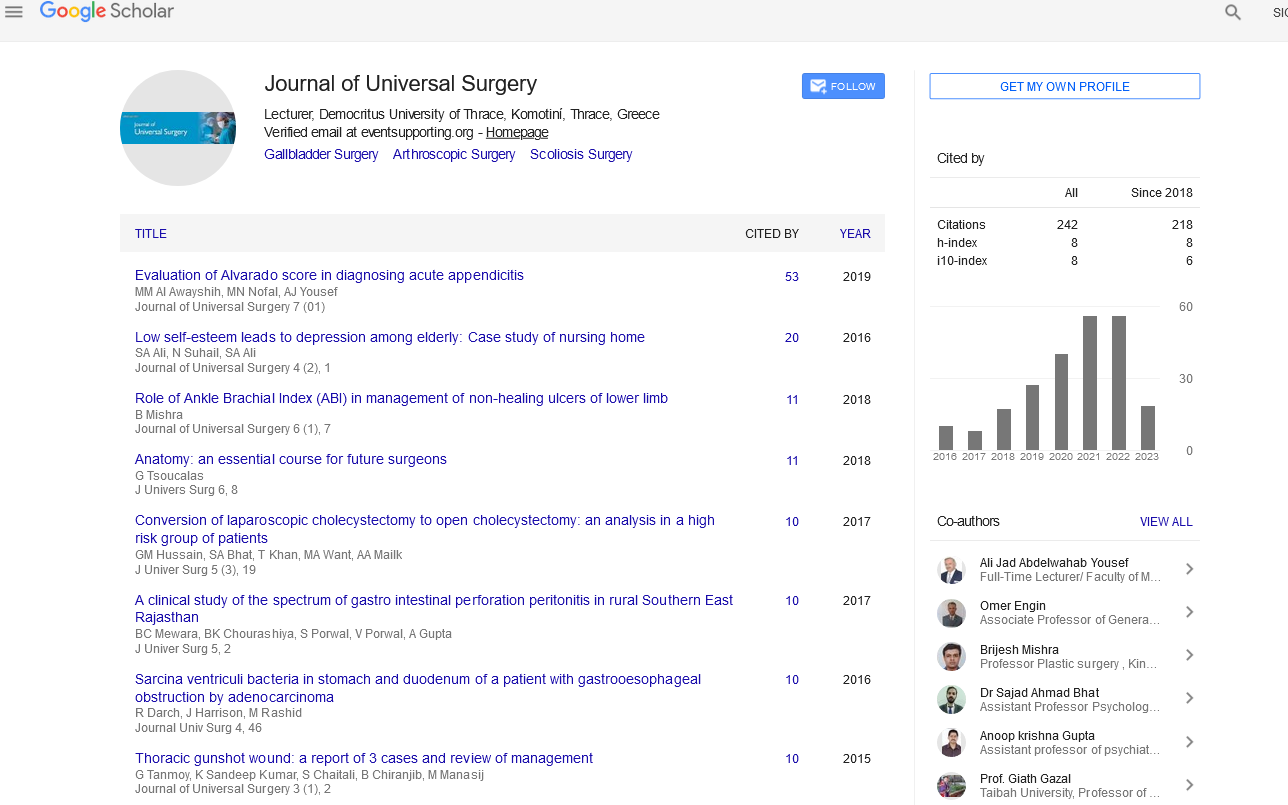Perspective - (2024) Volume 12, Issue 3
Surgical Methods for Cancer Treatments
Mike Lechin*
Department of Oncology, Durbuy Unversity, Durbuy, Belgium
*Correspondence:
Mike Lechin, Department of Oncology, Durbuy Unversity, Durbuy,
Belgium,
Email:
Received: 15-May-2024, Manuscript No. IPJUS-24-14864;
Editor assigned: 20-May-2024, Pre QC No. IPJUS-24-14864 (PQ);
Reviewed: 03-Jun-2024, QC No. IPJUS-24-14864;
Revised: 24-Jun-2024, Manuscript No. IPJUS-24-14864 (R);
Published:
27-Jun-2024
Introduction
Concurring to the Korea Central cancer registry's yearly
report of 2011, as distributed by the Korean Service of Wellbeing
and Welfare, Gallbladder (GB) cancer accounts for 1.1% of all
cancers in Korea, making it the 11th most predominant cancer
within the nation. In patients matured 65 yr or more seasoned,
it is the i th most predominant cancer. Its frequency ceaselessly
expanded between 1999 and 2002 and given that Korea is an
maturing society, this slant is anticipated to proceed. It is
therefore basic to set up viable rules for the determination and
fitting treatment of GB cancer.
GB cancer can be cured with radical surgery, and numerous
endeavors have been made within the endeavor to move
forward resectability and the survival rate. In any case, GB
cancer incorporates a moo rate, and no randomized, controlled
trials have been conducted to set up the ideal treatment
modalities. In spite of the fact that a number of review thinks
about have been conducted in huge arrangement of patients
with GB cancer, these have been limited in scope. Treatment
rules for GB cancer have been distributed in peer-reviewed
diaries in nations exterior of Korea, but these have been
constrained in their arrangement of set up, evidence-based
methods of reasoning for the foremost ideal surgical treatment
of GB cancer. The Korean Affiliation of hepato-biliary and
pancreas surgery conducted a efficient audit of the Korean and
English writing to set up standard treatment rules for GB cancer
and to progress treatment results.
Description
Portrayal
Concurring to distributed treatment rules, it is prescribed that
patients experience laparotomy in case they are suspected of
having GB cancer based on the preoperative work-up. This is
o ten based on the basis that GB cancer should be treated by
surgical modalities, such as laparotomic cholecystectomy,
hepatectomy for GB fossa, and lymph hub dismemberment. Be
that as it may, a few later thinks about have suggested that a
basic cholecystectomy ought to be the standard treatment
methodology for T1 GB cancer. Laparoscopic cholecystectomy
has appeared equivalent or superior treatment results
compared to those for laparotomy.
This has led to the sugggestion that patients ought to
experience laparoscopic cholecystectomy unless there is prove
of attack to the GB fossa (Level of prove 4, level of suggestion
B). Something else, a laparotomy would be prompted (level of
prove 3, level of suggestion B).
Surgical medications for other Gb cancer stages
An expanded cholecystectomy is for the most part suggested
for patients with GB cancer at arrange T2 or over (Level of prove
3, Level of proposal B). In patients who are demonstrated for
radical cholecystectomy, a combined approach can also be
considered.
Degree of hepatic resection in amplified
cholecystectomy
A wedge resection of the GB bed or segmentectomy IVb/V
can be performed (Level of prove 3, level of suggestion B). In a
wedge resection, it is prescribed that the hepatic resection edge
width ought to be proposed to be around 2 cm-3 cm; be that as
it may, there's by no means universal agreement on this point.
summarizes the proposals for the perfect degree of hepatic
resection in expanded cholecystectomy.
Degree of lymph hub dismemberment in expanded
cholecystectomy
Lymph node metastasis is a well-known prognostic pointer,
and its rate changes depending on the profundity of wall
painting attack as takes after:
pT1a, 0%-2.5%; pT1b, 5%-16%; pT2, 9%-30%; T3, 39%-72%;
and T4, 67%-80%. There's no agreement on the ideal degree of
lymph hub dismemberment in ampli ied cholecystectomy for GB
cancer patients. The seventh version of the AJCC cancer
arranging manual (23), characterizes, territorial lymph hub
gather 1 (N1) as comprising the cystic channel lymph hub,
common bile channel lymph hub, and the lymph hubs around
the hepatoduodenal tendon (i.e., the hepatic supply route
lymph hub and entrance vein lymph hub). The back
pancreaticoduodenal lymph hub, celiac course lymph hub,
superior mesenteric artery lymph hub, para-aortic lymph hub,
and pericaval lymph hub are classi ied as having a place
to territorial lymph node group 2 (N2).
N2 metastasis would be deciphered as inaccessible metastasis,
and such patients would be classi ied as TNM IVB. In most
cases, the long-term survival cannot be anticipated for
patients with N2 metastasis, and radical lymph node
dismemberment isn't routinely performed. Territorial lymph
hub dismemberment is prescribed for the cystic channel
lymph hub, common bile channel lymph hub, the lymph hubs
around the hepatoduodenal tendon (hepatic course and portal
vein lymph hubs), and the back predominant
pancreaticoduodenal lymph hub (Level of evidence 3, level of
suggestion C).
Conclusion
There are no randomized, prospective studies assessing
the surgical treatments for GB cancer. Moreover, there are as it were a few orderly audits of the GB cancer surgical writing.
There are numerous review thinks about in this
arrangement, but when taken as a entire, these have the
taking a ter impediments:
Little numbers of selected patients. Heterogeneity of
understanding populaces over considers, and con licting surgical
procedures over thinks about. Subsequently, we experienced
signi icant trouble in drawing conclusions and creating
suggestions based on the existing clinical prove. All things
considered, the current report is based on a precise survey of
the writing and in-depth dialog among board individuals. We
accept that these treatment guidelines are of esteem for
selecting the ideal surgical modalities in GB cancer patients.
Citation: Lechin M (2024) Surgical Methods for Cancer Treatments. J Univ Surg Vol.12 No.3: 027.





